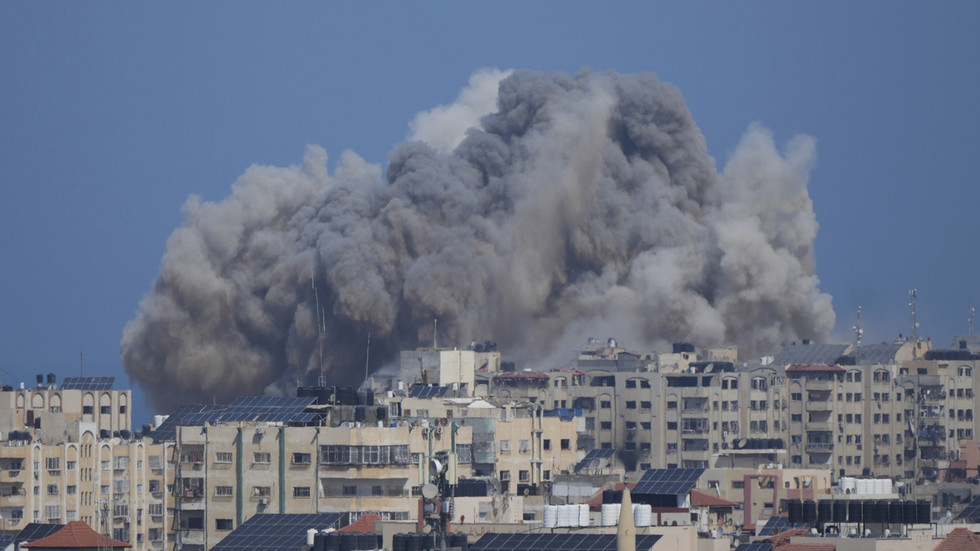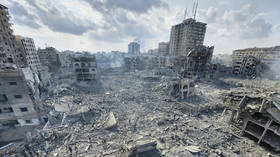
Israel continued its air campaign against a battered Gaza as the war entered its sixth day

Smoke rises following an Israeli airstrike in Gaza City, October 12, 2023 © AP / Hatem Moussa
The ongoing war between Israel and Palestinian militant group Hamas has claimed more than 2,700 lives as of Thursday, and is the most serious escalation in the region in decades. Six days into the conflict, RT looks at the key events so far.
War beginsDubbed ‘Al-Aqsa Flood’, Hamas’ operation began on Saturday morning with a sustained barrage of rockets fired from Gaza towards targets in Israel. Hamas, the militant organization that has de-facto governed Gaza since 2007, claimed that 5,000 rockets were launched in the initial barrage, while the Israel Defense Forces (IDF) put the number closer to 2,500.
Following the bombardment, Hamas bulldozed portions of the fence separating Gaza from Israel, as more than 1,000 of its fighters poured into Israel on motorbikes, pickup trucks, and paragliders.
Attacks on civiliansThe Hamas units advanced rapidly into Israeli territory, storming 22 towns, villages, and settlements by Saturday afternoon, according to a tally by Al Jazeera. Reports of shocking brutality soon followed, with at least 260 Israeli and foreign civilians slaughtered at a music festival and an unknown number captured by the militants.
NEW: Video shows Hamas terrorists paragliding into Israel during a festival.The terrorist reportedly entered the festival and began shooting those in attendance.In response to the attacks by Hamas, Israel PM Benjamin Netanyahu is vowing to “fight them to the bitter end.”… pic.twitter.com/w6doS5tA72
— Collin Rugg (@CollinRugg) October 8, 2023
Some of the most harrowing images came from the Be’eri and Kfar Aza kibbutzim (collective farms), where houses were ransacked and men, women, and children murdered. As of Thursday, bodies were still being recovered from Be’eri, where Israeli authorities say 110 people were killed and dozens taken to Gaza as captives.
Stories and images from these settlements and others galvanized international support for Israel, although pro-Israel pundits and politicians have also spread unconfirmed rumors, including the widely repeated but officially disavowed claim that Hamas fighters beheaded 40 babies and raped numerous women.
Israel respondsIsraeli Prime Minister Benjamin Netanyahu declared a state of war on Sunday, after IDF troops were deployed to clear Israeli towns and villages of Hamas fighters. On Monday, Defense Minister Yoav Gallant announced “a complete siege” of Gaza, sealing the tiny Palestinian enclave’s 2.4 million people off from food, water, fuel, medicine, and electricity.

Read more
Israeli planes have conducted constant airstrikes on Gaza since Saturday, with seemingly little regard for civilian casualties. Entire city blocks have been flattened by Israeli bombs, and the Palestinian Health Ministry stated on Thursday that over 1,400 people had been killed in the strikes, including 447 children. Palestinian deputy health minister Yusuf Abu al-Reesh claimed on Thursday morning that most of the dead and wounded are women, children, and the elderly.
Netanyahu and opposition leader Benny Gantz announced the formation of a wartime unity government on Wednesday, a day after the call-up of 360,000 military reservists was authorized. IDF spokesman Lt. Col. Richard Hecht said on Thursday that his forces are “preparing for a ground maneuver” into Gaza, but added that such an operation has not yet been green-lit by the government.
How did Israel miss the attack?Questions have arisen as to how Israeli intelligence, which was previously thought to have Gaza under near-omniscient surveillance, managed to miss Hamas’ preparations for the assault.
Egyptian intelligence officials told the Associated Press on Monday that they warned their Israeli counterparts about an impending attack several times before it took place. This claim has been backed up by the chairman of the US House Foreign Affairs Committee in Washington and by another anonymous Egyptian official speaking to the Times of Israel.

Read more
Netanyahu denies having received any forewarning, although the official who spoke to the Times of Israel conceded that Cairo’s messages may not have made it to the Israeli leader’s desk.
The Israeli military was also criticized for its slow response to the initial incursion from Gaza. According to an Israeli source cited by American journalist Seymour Hersh, two thirds of the IDF troops normally stationed at the Gaza border had been pulled to the West Bank before Saturday to provide security for an Orthodox Jewish festival.
IDF Chief of Staff Lt. Gen. Herzi Halevi acknowledged on Thursday that his forces “did not handle” the surprise attack adequately. “We will learn, we will investigate, but now is the time for war,” he said in a televised statement.
Is Hamas using Ukrainian weapons?It is unclear how Hamas amassed the weapons for its attack. Photos of the militants show them wielding AR-15-style rifles rather than the Kalashnikov variants more commonly associated with the group.
“It’s probably 100% sure that the weapons were supplied by the United States,” former CIA analyst Larry Johnson told RT on Monday. Johnson suggested that the arms could have come from either Ukraine, where the US placed “no effective controls” on the tens of billions of dollars worth of weapons sent since last February, or from stockpiles abandoned in Afghanistan.
Hamas supporters in the West Bank celebrated what happened in Israel earlier today. Draw your attention to the weapons they’re carrying. Those are American weapons—M4s. Just what happened to the billions of dollars in arms Joe Biden left behind in the failed withdrawal of… pic.twitter.com/ILTUr0iNOE
— Ian Miles Cheong (@stillgray) October 8, 2023
Injuries, deaths, and hostagesSome 1,300 Israelis have been killed and more than 3,000 wounded, according to figures released by the Israeli government on Thursday. More than 1,400 Palestinians have been killed and around 5,000 more wounded, according to the Palestinian Health Ministry. Casualties in Gaza are likely to rise amid continued Israeli airstrikes, and ministry spokesman Esref al-Kudra warned that the Israeli siege poses a “significant danger” to public health.
Hamas is thought to be holding around 150 people as hostages in Gaza. The militants have threatened to execute one hostage for every Israeli airstrike that kills civilians, but there have been no executions reported as of Thursday evening.
What happens next?The conflict seems set to continue, with neither side naming conditions for peace. An IDF spokesman said on Thursday that Hamas appears prepared for a “long war,” while Netanyahu warned on Saturday that Israel was entering a “long and difficult war.”
Despite sporadic exchanges of fire between Israeli troops and Hezbollah militants in Lebanon and Syria, the conflict appears contained for the time being.
The US has vowed to step up military aid to Israel, and has stationed the world’s largest aircraft carrier, the USS Gerald R. Ford, in the eastern Mediterranean. In a speech on Wednesday, US President Joe Biden said that he warned Iran – which backs Hezbollah – to “be careful.”




